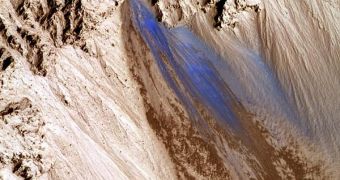New images of a recent landslide in the Martian crater Zunil show astonishing blue streaks on the walls. This image was taken by the High Resolution Imaging Science Experiment (HiRISE) camera aboard NASA's Mars reconnaissance orbiter.
There's a catch, though. This is a false color picture and its purpose is to show areas recently disturbed by an avalanche. HiRISE is a 70 Kg, $40 million dollar (US) instrument, consisting of a 0.5 meter reflecting telescope, the largest of any deep space mission, which allows it to take pictures with resolutions up to 0.3 m resolving objects about a meter across, or the size of a beachball.
Zunil is a crater on Mars, 10 kilometers wide, lying just north of Mars's equator. It was created a few million years ago or less, when a meteorite struck Mars' Cerberus Plains and gave birth to this large crater. The impact that Zunil made spewed enough debris fragments to gouge an estimated 10 million secondary craters bigger than 10 meters (33 feet) wide.
The novelty of the picture is the fact that the reddish dust that coats much of the Martian surface is absent from the areas where the avalanche passed, indicating that the disturbance is recent. It is believed that the impact making the 10 km (6 mile) crater may even have shot some fragments to Earth.
The most probable cause for the landslide is a Marsquake, although an impact with a small meteor is not excluded. Also around the edges of the carter, there is strong evidence of a much bigger ancient landslide that occurred on the slopes of Mars's Olympus Mons, the largest volcano in the solar system, in the form of a halo of material around the volcano.
"When there's that much rock flowing like that, it does things like water does," says Laszlo Keszthelyi, a scientist with the HiRISE team based in Flagstaff, Arizona, US. It's much like sand pouring like a liquid, even though it is made up of solid particles.

 14 DAY TRIAL //
14 DAY TRIAL //